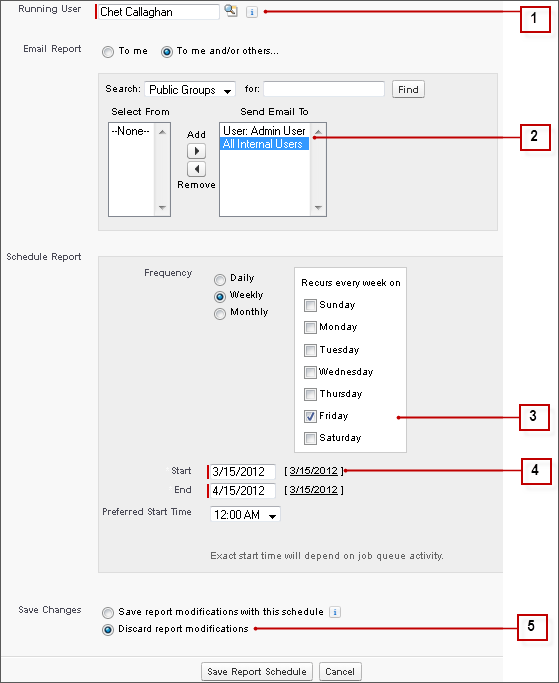Schedule a report to run daily, weekly, or monthly. An HTML version of the report can be sent by email to users in your organization.
| Available in: Salesforce Classic and Lightning Experience |
| Available in: Professional, Enterprise, Performance, Unlimited, and Developer Editions |
| Available in: Enhanced Folder Sharing and Legacy Folder Sharing |
| User Permissions Needed | |
|---|---|
| To create, edit, and delete reports: |
|
Watch a Demo: Tips for Scheduling Reports (Salesforce Classic)
- On the Reports tab, click a report name.
- Click Schedule Future Runs from the Run Report drop-down menu.If you’re creating a new report, you are asked to save the report in a folder before scheduling. If the report folder is shared with a group, you can schedule the report only for the entire group. To schedule the report for an individual group member, share the report folder with that member.
- On the Schedule Report page, specify a running user who has access to the folder where the report is stored.The access level of the running user determines what other users, including portal users, see when they receive the scheduled report run results. This means that not all users can see every field, and the running user can see fields that others may not be able to see. When it’s sent, the report indicates which fields the running user can see that can’t be viewed by others. You need the “View All Data” permission to specify a running user other than yourself.
NoteIf the running user becomes inactive, the report doesn’t run. Salesforce sends an email notification to either activate the user, delete the report schedule, or change the running user to an active one. Salesforce sends the notification to users with the “Manage Users,” “Modify All Data,” and “Manage Billing” permissions. If no user has all these user permissions, Salesforce sends the notification to users with the “Manage Users” and “Modify All Data” user permissions. - Select an email setting.
Select To To me Send the report to your email address specified on your user profile. To me and/or others Email the report to additional users. You can send reports only to email addresses included on Salesforce user records. When portal users receive emailed reports, they see the same data as the running user set in the report schedule. If you have information you’d rather not share, schedule the report to run with a portal user as the running user.
NotePortal users receive report and dashboard refresh email notifications when the Allow Reports and Dashboards to Be Sent to Portal Users option is enabled. - Set the frequency, duration, and time for running the report:
- In the Frequency field, select Daily, Weekly, or Monthly and then refine the frequency criteria.
- Using the Start and End fields, specify the dates during which you want to schedule the report. To enter the current date, click the link showing the date.
- Next to Preferred Start Time, click Find available options to choose a start time.
Your preferred start time might not be available if other users have already selected that time to schedule a report. - Click Save Report Schedule. You can choose:
Choose To Save report modifications with this schedule Save both the report schedule and changes you made to the report. Discard report modifications Save the schedule only. Changes you made to the report are discarded.
Report recipients can click the report name in emailed reports to log in to Salesforce and view the report directly.
Example
A report is scheduled to run every Friday at midnight, and its results are emailed to a selected group and user.

- All users, including portal users, viewing the scheduled report see the report data that Sales Director Chet’s access level allows.
- Report run results are set to be emailed to a public user group called All Internal Users and the admin user. You can only send emails to users and groups with access to the report folders. The Search drop-down displays all available categories based on your search criteria in the Running User field.
- The report is scheduled to run every Friday.
- The report run is scheduled to start on the current date.
- The schedule is saved without saving prior changes made to the report.


Scheduling a report for refresh ensures that your data is always up-to-date and readily available for analysis. By automating this process, you save time and can focus on deriving insights rather than manual updates. For optimal performance, don't forget to check out Skynode for tools that can streamline your reporting process!
ReplyDelete